Stranieri Ovunque, Foreigners Everywhere, the theme identified by curator Adriano Pedrosa for the 60th edition of the Venice Biennale Arte, derives from an artwork by the Italian-British collective Claire Fontaine, a neon sculpture that welcomes the public in a double-faced version at the entrance to the Central Pavilion at the Giardini venue and then reappears in a widespread and multilingual form as an ideal conclusion to the visit to the Arsenale.
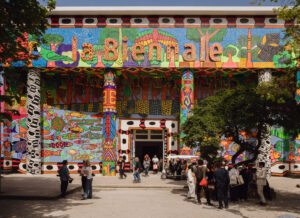
MAHKU (Movimento dos Artistas Huni Kuin), “Kapewe Pukeni [Bridgealligator]”, 2024, site-specific installation, 750 m2, 60th International Art Exhibition – La Biennale di Venezia, “Stranieri Ovunque – Foreigners Everywhere”, photo by Matteo de Mayda, courtesy La Biennale di Venezia
The input is cogent and extremely current in summarizing the estrangement and contradictions of the globalized world community, in which goods circulate freely but people must submit to different restrictions depending on their origin and where individual countries hold such powerful weapons enough to explode the planet they threaten to use to radically resolve particularistic conflicts. We hear from many quarters that we are on the brink of the Third World War, a prospect (not so unjustifiably catastrophic, as it is demonstrated by the most recent geopolitical events) which ultimately has roots precisely in the attitude of perceiving the other as dangerously foreign and therefore like a potential enemy. Art should be a sensitive seismograph of our time for its capability to detect and interpret connections, facts and orientations starting from points of view free from their official systematization, opening new horizons of awareness about our being in the world.
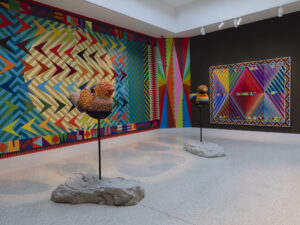
Pavilion of UNITED STATES OF AMERICA, “Jeffrey Gibson: the space in which to place me”, 60th International Art Exhibition – La Biennale di Venezia, “Stranieri Ovunque – Foreigners Everywhere”, photo by Matteo de Mayda, courtesy La Biennale di Venezia
This is what one would expect (and what would be needed) in relation to a topic like the one proposed, together with a powerful review of highly significant works also from the point of view of the artistic research, given the international prestige of the exhibition opportunity and the consequent financing possibilities, which far exceed the budget available for the majority of exhibitions. It is therefore disappointing to note in the international exhibition that the disruptive potential of the proposed topic has been diluted into yet another apology for the excluded (from history, politics and the art system), an expression of a mannered anti-colonialism. The complexity of the problem therefore seems once again to be resolved in a simplistic way in the valorisation of non-Western artists making their debut at the Biennale and preferably coming from minorities, whose poetics recover in various ways expressive languages which seek in traditional practices the push for claims of the present. It is emblematic in this regard the façade of the Central Pavilion in the Giardini venue entirely covered by the mural created by the indigenous Amazonian artistic collective MAHKU (Movimento dos Artistas Huni Kuin) which tells the story of kapewë pukeni (the alligator bridge) in neopop style. Here, the mythical origin of the separation between the Asian and American peoples is traced back to the betrayal by men of the trust of the alligator who carried them on his back across the Bering Strait.

Pavilion of NORDIC COUNTRIES (SWEDEN, NORWAY, FINLAND), “The Altersea Opera”, 60th International Art Exhibition – La Biennale di Venezia, “Stranieri Ovunque – Foreigners Everywhere”, photo by Matteo de Mayda, courtesy La Biennale di Venezia
The programmatically folk, naive and regressively ritual direction of the international exhibition also reverberates in the choices of the National Pavilions curators, who seem to compete to exhume stories, techniques and aesthetics united by the intent (more or less ethically authentic) of pursuing the coveted “certification of anti-colonialist conformity”. It is paradigmatic in this regard is, for example, the American Pavilion, in which for the first time the solo representation of the country is entrusted to an Indigenous artist, Jeffrey Gibson, who hybridises Native American motifs, geometries and craftsmanship with bright colors belonging to the digital and queer activism texts. Or the Pavilion of the Nordic Countries, where the audiovisual installation The Altersea Opera, conceived by the artist Lap-See Lam (Sweden) and created in collaboration with the experimental composer Tze Yeung Ho (Norway) and the textile artist Kholod Hawash (Finland ), celebrates the Cantonese mythological figure of the Lo Ting – half fish, half man – with a monumental dragon ship (to build which Lap-See Lam worked closely with Hong Kong master bamboo scaffolding craftsman Ho Yeung Chan) and a performance in which the actors wear clothes embellished with embroidery depicting mythological creatures.

Pavilion of SPAIN, “Pinacoteca Migrante / Migrant Art Gallery”, 60th International Art Exhibition – La Biennale di Venezia, “Stranieri Ovunque – Foreigners Everywhere”, photo by Matteo de Mayda, courtesy La Biennale di Venezia
And again, to conclude a triad arbitrarily selected among many other possible examples, the Netherlands Pavilion, which has chosen to host the collective of Congolese artists Cercle d’Art des Travailleurs de Plantation Congolaise (CATPC) based in Lusanga, in a plantation once belonged to the multinational Unilever, whose archaically brutal sculptures stigmatize old and new episodes of exploitation and oppression against the local community. The peak of this approach is reached in the Spanish Pavilion, within which the Peruvian Sandra Gamarra Heshiki (the first foreign artist to represent the nation at the Biennial) recreates a true museum of Spanish colonization in Latin America, with the unequivocal title Migrant Art Gallery. The exhibition hosted there is divided into five sections in which there are herbariums of weeds assimilated to human invaders, artisanal artefacts and textual or deletion interventions on reproductions of iconic Spanish artworks. The project is so didactic in its way of denouncing silenced cultures that it turns out (and if this were the intent, the idea would be brilliant!) an ironic staging of the most recurrent processes of decolonization in art, which confirms its inflation as a consolidated maistream from recent years.
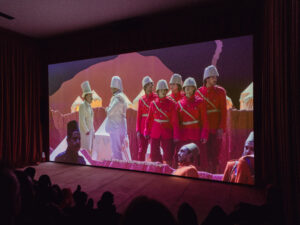
Pavilion of EGYPT, “Drama 1882″ – 60th International Art Exhibition – La Biennale di Venezia, “Stranieri Ovunque – Foreigners Everywhere”, photo by Matteo de Mayda, courtesy La Biennale di Venezia
In contrast with this generalized and uncritical assumption of the guilt complex by Western nations, which is counterbalanced by the (equally artistically predictable) enunciation of abuses by the victims, let us now review some of the pavilions that stand out most for originality of language and reworking of the theme. Let’s first mention the Egypt Pavilion, where Wael Shawky presents the eight-act film Drama 1882, focused on the nationalist revolt against British and French imperial rule (1879-1882) led by the colonel of peasant origins Aḥmad ʿOrābī, who tried to depose the Khedive Tawfīq Pasha and put an end to European influence on the country. The opera, masterful in its orchestration of crowds of actors in period costumes, handcrafted environmental sets and a concept of contemporary opera deeply rooted in tradition, reflects on the intricate gestation of Egyptian national identity by emphasizing contradictions, ambiguities and mystifications of policies underlying historical events. The universal scope of the typification of the roles of the characters on stage is movingly effective in exposing winners and losers as helpless puppets of a history indifferent to the destinies of humanity.

Pavilion of POLAND, “Repeat after Me II”, 60th International Art Exhibition – La Biennale di Venezia, “Stranieri Ovunque – Foreigners Everywhere”, photo by Matteo de Mayda, courtesy La Biennale di Venezia
The Polish Pavilion stands out in its singularity, with the participatory video installation Repeat after me II by the Open Group collective (Yuriy Biley, Pavlo Kovach, Anton Varga). The protagonists of the two videos are Ukrainian civilians, war refugees who re-elaborate the trauma of the conflict by recreating with onomatopoeic sounds the noises of the armaments that they have learned to recognise, inviting the public to repeat them in a destabilizing karaoke. Bullet discharges, cannon shots, alarms, sirens and explosions are erected as the universal language of militarized humanity, the terminal idiom of a future subjected to nationalist and imperialist policies. In the French Pavilion Julien Creuzet presents the environmental installation Attila cataracte ta source aux pieds des pitons verts finira dans la grande mer gouffre bleu nous nous noyâmes dans les larmes marées de la lune. A joyful hymn to the multiple constellations of life that peace would make possible, the video installation immerses the visitor in an amniotic underwater environment, where moving images projected across the entire wall merge in an unexpectedly happy way with delicate sculptures in poor materials scattered throughout the physically accessible space. What is proposed here (although without particular depth) is an enchanting model of coexistence based on the poetry of things, a refined childish space in which to savor for a moment a state of absolute calm.

Pavilion of GERMANY, “Thresholds”, 60th International Art Exhibition – La Biennale di Venezia, “Stranieri Ovunque – Foreigners Everywhere”, photo by Matteo de Mayda, courtesy La Biennale di Venezia
The German Pavilion proposes a complex project, entitled Thresholds, which involves the artists Yael Bartana and Ersan Mondtag in its usual location at the Giardini venue, transformed into a sort of basement bunker, and Michael Akstaller, Nicole L’Huillier, Robert Lippok and Jan St. Werner at Isola Della Certosa. Yael Bartana imagines the escape from a world on the brink of economic and political devastation in a futuristic epic, in strong debt to science fiction filmography, in which the Germanic woodland mythological imagery is combined with the mystical teachings of the Jewish cabal, passing through speculative technologies. Opera and theater director Ersan Mondtag contrasts the triumphant visionary nature of the Israeli visual artist with his living Monument eines unbekannten Menschen (monument to an unknown human being), inspired by the story of his grandfather, Hasan Aygün, who moved to from central Anatolia to West Berlin to work in the factories of the Eternit company, producer of the lethal asbestos which was also the cause of his death. In a tower that seems to allude to the eternal repetition of these forgotten migration stories, the artist together with five performers recall anti-heroic biographical fragments in a noir happening set in a squalid DDR-style apartment. The work, openly aestheticizing and mannered, is disturbing in its ability to make us experience the atmosphere of an existential condition that overwhelms historiographical reference.
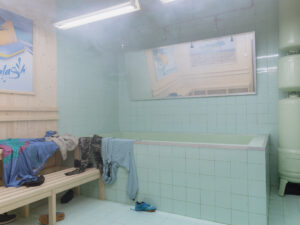
Pavilion of SERBIA, “Exposition Coloniale”, 60th International Art Exhibition – La Biennale di Venezia, “Stranieri Ovunque – Foreigners Everywhere”, photo by Matteo de Mayda, courtesy La Biennale di Venezia
In some ways, it is similar to the latter the environmental installation Colonial Exposition by Aleksandar Denić in the Serbia Pavilion, composed of a micro village of habitable architectural modules that reproduce ordinary environments from a recent past, such as a telephone booth, a sauna, a kiosk with working jukebox, a bedroom with the television on, each of which is perceived as anachronistic or artificial. What the artist proposes is a sort of conceptual theater of the soul of objects under the aegis of the reversed writing EUROPE, in which he invites us to identify the traces of the transitory nature of every society. Austere and essential, the Romania Pavilion offers a gallery of paintings and mosaics inspired by socialist realism, created by Șerban Savu and Atelier Brenda (Nana Esi, Sophie Keij). The regime’s iconography, emptied of its ideological significance and verified in its naked essentiality, leads contemporary alienation to an ambiguous indistinction between work and rest and to the obsolescence of the former as a paradigm for the construction of people in a society increasingly disconnected from their real needs.
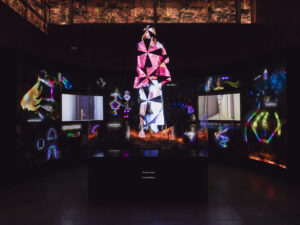
Pavilion of SWITZERLAND, “Super Superior Civilizations”, 60th International Art Exhibition – La Biennale di Venezia, “Stranieri Ovunque – Foreigners Everywhere”, photo by Matteo de Mayda, courtesy La Biennale di Venezia
The Swiss Pavilion amazes with the multimedia installation Super Superior Civilizations by Guerreiro do Divino Amor, which satirizes with phantasmagoric intelligence the national logic of celebratory self-representation underlying mass media communication. Divided into two parts, Miracle of Helvetia and Roma Talismano, the exhibition subverts and exasperates the clichés in which crucial political issues, such as the management of power and collective imagination by the media, finance and religion, are formalized. Through sharp collisions of meaning and hyperbolic hallucinations, the artist mocks the fictional nature of every official attempt to construct national identities to fundamentally deny the narrative from which the presumption of superiority of Western civilization draws strength. Switzerland is described here as a happy capitalist paradise in which the well-being of the population, the protection of nature and cutting-edge technological development are guaranteed by Helvetia, the imperturbable mother goddess responsible for the country’s financial prosperity. The spirit of Rome, however, is personified by an overabundant Brazilian queer divinity who magnifies its thousand-year-old beauties.

Pavilion of ICELAND, “That’s a Very Large Number — A Commerzbau”, 60th International Art Exhibition – La Biennale di Venezia, “Stranieri Ovunque – Foreigners Everywhere”, photo by Andrea Avezzù, courtesy La Biennale di Venezia
At the Arsenale venue, we highlight the Irish Pavilion with the multi-channel video installation Romantic Ireland by Eimear Walshe, a post-modern saga of generational and class antagonisms that ideally reconnects the land dispute from the late nineteenth century in Ireland and the housing crisis currently underway in the country. The action is set on a construction site using the ancient raw earth technique, a form of vernacular architecture that involved the collaboration of groups of workers, defined as “meitheal”, brought together by parental or residential proximity. On the screen, eclectically dressed performers wearing fetish latex masks and nineteenth-century clothes mime scenes of oppression in which even the fleeting hypotheses of conciliation that emerge are subtly disturbing. The soundtrack of the drama is an opera composed by Amanda Feery with a libretto by Eimear Walshe, which recalls an eviction that took place on 1943 while the Prime Minister from that time was giving the speech The Ireland that we dreamed of live on the radio. This surreal re-enactment stigmatizes the violence inherent in the political exploitation of citizens’ lives by rulers from all eras. We conclude this excursus by mentioning the Iceland Pavilion, dedicated to the conceptual installation That’s a Very Large Number – A Commerzbau by Hildigunnur Birgisdóttir. The artist appropriates the icons and language of mass production in an immersive and dematerialized project that follows the tradition of the “Merzbau”, by the German Dadaist Kurt Schwitters.
Info:
60th Biennale Arte
20/04 – 24/11/2024
Venezia, Giardini – Arsenale
https://www.labiennale.org/it/arte/2024
Graduated in art history at DAMS in Bologna, city where she continued to live and work, she specialized in Siena with Enrico Crispolti. Curious and attentive to the becoming of the contemporary, she believes in the power of art to make life more interesting and she loves to explore its latest trends through dialogue with artists, curators and gallery owners. She considers writing a form of reasoning and analysis that reconstructs the connection between the artist’s creative path and the surrounding context.






NO COMMENT